Caecilian Care Sheet: (Herpele squalastoma and Geotrypetes seraphini)
Common name: Caecilians
There are over 155 known species of Caecilian, but this number may not be entirely correct, because Caecilians are one of the least known creatures on this earth. They spend a lot of time underground and have rarely been seen by man, so there may be many more species of Caecilian out there that have not been discovered yet.
Only a few species of Caecilian are commonly kept as pets. Some Caecilians have a burrowing lifestyle, while some are fully aquatic.
Scientific name: Caecilian is derived from caecus meaning ‘blind’ in Latin. The name is quite misleading as Caecilians are not actually blind, their eyes are just really small.
Caecilians belong to the familae Gymnophiona or Apoda, which has it’s own misinterpretation. The name is derived from the Latin ‘gymnos’ (naked) and ophis (snake), but the Caecilian is not a snake at all, being an amphibian rather than a reptile.
Here are the Latin names of some of the fossorial Caecilians that can be kept in captivity as pets:
Cameroon Blue Caecilians: Herpele squalastoma
West African/Gaboon Caecilian: Geotrypetes seraphini
Description
Description: Caecilians are limbless creatures with small eyes and ring-shaped segmented folds all along their bodies. They have smooth skin, which is usually matt in dark colours like grey, green and black. Although they look similar to earthworms, snakes and eels, they are actually not related to any of these animals.
Size: Caecilians generally grow to between 12- 37 CM (5 – 15 Inch), but some have been known to reach 4.5 ft long.
Life span: (Captive) Caecilians can live between 5 - 20 years with appropriate care.
Origin: Caecilians are found in South East Asia, Africa, South America, South China, New Zealand and Vietnam.
Habitat: Caecilians live in the muddy ground in rainforests and in swamps in tropical parts with moist climates. They spend a lot of their time below ground and hidden in the undergrowth, but they are also good swimmers and can live mostly-aquatically.
Captive Care
Temperament: Caecilians are docile and quiet pets, which are very interesting to watch. They are a little harder to keep than some amphibians, so are not recommended for someone who has not kept amphibians before.
They can live with other caecilians. They tend to group together and can often be seen sharing the same hide outs.
They can bite, but this is rare with appropriate handling.
Housing: Caecilians need a 50/50 split within their tank, with half being covered with a burrowing substrate, while the other being a water area.
A tight fitting lid is also required as Caecilians are excellent escape artists.
Cleaning: Your Caecilian’s terrarium should be inspected and spot cleaned daily when changing the water. Every week clean out the tank completely and sterilise using a reptile/amphibian friendly disinfectant. Sterilise any décor and carefully remove any live plants to replace when the tank has been cleaned. Your Caecilian(s) should be moved to a temporary tank whilst being cleaned.
It is important to keep your caecilian’s tank clean at all times because of the bacterial build up created by the high temperatures and humidity. Caecilians can also carry parasites, so care must be taken to ensure these parasites stay at a containable level. Too many parasites can kill your caecilian.
Handling: All amphibians are delicate skinned and oils and salts on our skin can cause them harm. Caecilians also excrete a toxin through their skin to scare off predators. It is recommended to wear gloves if the need to handle arises, to keep both you and your caecilian safe.
A large aquarium net can also be used to move your Caecilian.
Shedding: Caecilians shed their skin at regular intervals as they grow. The shed skin is nearly transparent and you will find it floating in the water of your terrarium. The skin should be netted out of the tank as soon as possible after shedding to keep the water clean.
Feeding
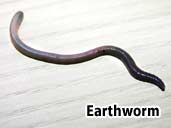 |
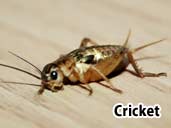 |
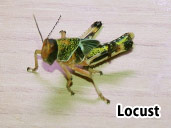 |
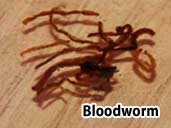 |
Caecilians should be fed daily with a varied diet of appropriately sized gut loaded prey items, including most insects and inverts, earthworms, small fish, shrimps, and frozen bloodworm.
Your Caecilian’s terrarium should contain:
Substrate
50% of your terrarium should contain a burrowing substrate, as your caecilian will spend a lot of time under the soil. A fertiliser free soil, peat, Eco-earth or a coco husk substrate would be fine for this.
Sphagnum moss is also a good addition to your terrarium.
A place for your Caecilian to hide
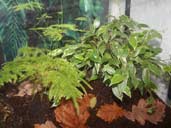 All amphibians require somewhere to hide and may become stressed if this is not provided. In the case of Caecilians, hiding places must be provided in both the soil and water sides of the terrarium. This could be a plant pot on its side, which is low cost but easily cleaned if it becomes soiled.
All amphibians require somewhere to hide and may become stressed if this is not provided. In the case of Caecilians, hiding places must be provided in both the soil and water sides of the terrarium. This could be a plant pot on its side, which is low cost but easily cleaned if it becomes soiled.
Logs and cork bark make good natural looking additions to your terrarium and make great hiding places. Plants and stones can also be used.
Stones or branches from the wild need to be debugged by soaking first in chlorine/water solution, then rinsed thoroughly, soaked in clean water, then left to dry in the sun. Some live plants may be harmful to your Caecilian, if in doubt please see the list of safe plants which can be used in the forum.
A change of scenery
Caecilians are very inquisitive animals and like to explore new surroundings. Once in a while change the layout of the terrarium; this will keep your Caecilian from becoming bored. You will notice once you put your Caecilian(s) back in the tank it will start to re-explore its new surroundings.
Water
Caecilians are good swimmers and may spend quite a lot of their time in their water. Half the terrarium should be dedicated to providing adequate water for your caecilians. The water should be changed daily to avoid the build up of bacteria, unless a filter can be provided to keep the water clean.
Caecilians like most amphibians will soak up water through their skin and since their water bowl is used as the main place to defecate it is important that it is cleaned regularly.
Humidity
Misting the tank regularly with de-chlorinated or bottled spring water will ensure that the substrate does not dry out. Caecilians need to keep their skin moist, but the substrate should be kept damp and not water-logged.
Heat
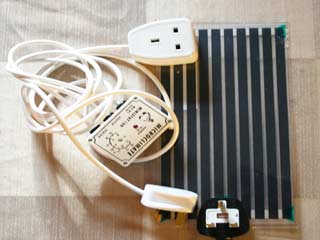 The ideal temperature for your Caecilian(s) is a temperature of around 21- 27°C (70-80°F) with a slight temperature drop at night or 2 or 3 degrees.
The ideal temperature for your Caecilian(s) is a temperature of around 21- 27°C (70-80°F) with a slight temperature drop at night or 2 or 3 degrees.
In the summer months it may not be necessary to provide additional heat, but in the winter, heat should be provided using a heat mat regulated with the appropriate thermostat. Heat mats should only cover between a third and a half of the wall space to allow your Caecilian to thermo regulate.
Never use heat lamps or basking lamps for amphibians, as these can cause your Caecilians to dehydrate.
It's useful to have a small thermometer on either end of the terrarium to check the temperature. One end should be around room temperature and the other around 27°C. Your Caecilian(s) will thermo-regulate by moving around the tank.
Lighting
Caecilians do not need the edition of UV lighting, although you may find the live plants in your terrarium will die without any light. A fluorescent low UVB tube is ideal as it won’t give out any heat and will help the plants thrive. You should place the light at one side of the terrarium creating a light gradient so your Caecilians can find a darker place out of the light if preferred. Ideally you should cycle the lighting to mimic the Caecilians natural habitat by having a 12/12 system - 12 hours of light and 12 of dark.
Sexing
The sex of your Caecilian cannot be determined externally through appearance, as males and females look the same.
Breeding
Caecilians can be oviparous, viviparous and ovoviviparous, depending on the type of Caecilian you have.
The breeding act usually lasts between 2-3 hours, in which internal insemination of the female occurs.
The larvae will spend a lot of time in the water, but are not fully aquatic. They can be fed on bloodworm or chopped up adult food.
Pet Caecilian larvae will usually fend for themselves from birth, but some species of Caecilian have an unusual way of feeding their young. The female will build up her flesh, for the larvae to eat and by doing so they grow at a surprising rate. This has been captured on film for the first time during a David Attenborough documentary (Life in Cold Blood - BBC 2008).
Click here to see the video on You Tube.
Other questions about the Caecilian
This care sheet is a simple step-by-step guide to successful Caecilian keeping, but if you have any more questions or need more specific information about the keeping of Caecilians, please enter our forum. It is a useful resource where you can ask members to share good practice and also talk about your experiences of being a Caecilian keeper.

